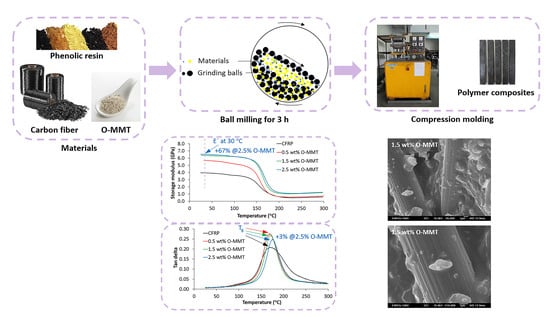Effect of Organo-Modified Montmorillonite Nanoclay on Mechanical, Thermo-Mechanical, and Thermal Properties of Carbon Fiber-Reinforced Phenolic Composites
Abstract
:1. Introduction
2. Materials and Methods
2.1. Materials
2.2. Preparation of the CFRP/O-MMT Composites
2.3. Characterization
3. Results
3.1. Density and Void Content of the CFRP/O-MMT Composites
3.2. Mechanical Properties of the CFRP/O-MMT Composites
3.3. Thermo-Mechanical Properties of the CFRP/O-MMT Composites
3.4. Thermal Properties of the CFRP/O-MMT Composites
3.5. Thermal Stability of the CFRP/O-MMT Composites
3.6. Fracture Surface Morphology of the CFRP/O-MMT Composites
4. Conclusions
- The addition of O-MMT can efficiently enhance the interfacial interaction between carbon fiber and phenolic matrix, leading to the improvement of the CFRP.
- The use of 1.5 wt% O-MMT as a secondary reinforcement was optimum in the CFRP for improving by 20% tensile strength, 11% Young’s modulus, 4% bending modulus, 51% impact strength, 67% storage modulus, similar glass transition temperature, and 1% heat deflection temperature, compared to the CFRP. It increased the thermal degradation temperature of the CFRP to 630 °C. However, it showed a little lower bending strength, which decreased by 1%.
- Morphology analysis indicated that O-MMT significantly improved carbon fiber–polymer matrix interfacial bonding; nevertheless, O-MMT was found to agglomerate at a high loading content.
- Overall, it can be concluded that the incorporation of a small content of O-MMT is beneficial to the mechanical, thermo-mechanical, and thermal properties of CFRP for use as a heat resistant material.
Author Contributions
Funding
Institutional Review Board Statement
Informed Consent Statement
Data Availability Statement
Acknowledgments
Conflicts of Interest
References
- Zakaria, M.R.; Akil, H.M.; Kudus, M.H.A.; Ullah, F.; Javed, F.; Nosbi, N. Hybrid carbon fiber-carbon nanotubes reinforced polymer composites: A review. Compos. Part B 2019, 176, 107313. [Google Scholar] [CrossRef]
- Forintos, N.; Czigany, T. Multifunctional application of carbon fiber reinforced polymer composites: Electrical properties of the reinforcing carbon fibers—A short review. Compos. Part B 2019, 162, 331–343. [Google Scholar] [CrossRef]
- Das, T.K.; Ghosh, P.; Das, N.C. Preparation, development, outcomes, and application versatility of carbon fiber-based polymer composites: A review. Adv. Compos. Hybrid. Mater. 2019, 2, 214–233. [Google Scholar] [CrossRef]
- Huang, M.; Li, W.; Liu, X.; Feng, M.; Yang, J. The effects of cauliflower-like short carbon fibers on the mechanical properties of rigid polyurethane matrix composites. Polym. Test. 2020, 89, 106718. [Google Scholar] [CrossRef]
- Yao, X.; Gao, X.; Jiang, J.; Xu, C.; Deng, C.; Wang, J. Comparison of carbon nanotubes and graphene oxide coated carbon fiber for improving the interfacial properties of carbon fiber/epoxy composites. Compos. Part B 2018, 132, 170–177. [Google Scholar] [CrossRef]
- Azimpour-Shishevan, F.; Akbulut, H.; Mohtadi-Bonab, M.A. Synergetic effects of carbon nanotube and graphene addition on thermo-mechanical properties and vibrational behavior of twill carbon fiber reinforced polymer composites. Polym. Test. 2020, 90, 106745. [Google Scholar] [CrossRef]
- Liu, L.; Jia, C.; He, J.; Zhao, F.; Fan, D.; Xing, L.; Wang, M.; Wang, F.; Jiang, Z.; Huang, Y. Interfacial characterization, control and modification of carbon fiber reinforced polymer composites. Compos. Sci. Technol. 2015, 121, 56–72. [Google Scholar] [CrossRef]
- Wu, G.; Ma, L.; Wang, Y.; Liu, L.; Huang, Y. Interfacial properties and impact toughness of methylphenylsilicone resin composites by chemically grafting POSS and tetraethylenepentamine onto carbon fibers. Compos. Part A 2016, 84, 1–8. [Google Scholar] [CrossRef]
- Wang, Y.; Meng, L.; Fan, L.; Wu, G.; Ma, L.; Huang, Y. Preparation and properties of carbon nanotube/carbon fiber hybrid reinforcement by a two-step aryl diazonium reaction. RSC Adv. 2015, 5, 44492–44498. [Google Scholar] [CrossRef]
- Zabihi, O. Preparation and characterization of toughened composites of epoxy/poly(3,4-ethylenedioxythiophene) nanotube: Thermal, mechanical and electrical properties. Compos. Part B 2013, 45, 1480–1485. [Google Scholar] [CrossRef]
- Jahangiri, A.A.; Rostamiyan, Y. Mechanical properties of nano-silica and nano-clay composites of phenol formaldehyde short carbon fibers. J. Compos. Mater. 2019, 54, 1339–1352. [Google Scholar] [CrossRef]
- Mirzapour, A.; Asadollahi, M.H.; Baghshaei, S.; Akbari, M. Effect of nanosilica on the microstructure, thermal properties and bending strength of nanosilica modified carbon fiber/phenolic nanocomposite. Compos. Part A 2014, 63, 159–167. [Google Scholar] [CrossRef]
- Islam, M.E.; Mahdi, T.H.; Hosur, M.V.; Jeelani, S. Characterization of carbon fiber reinforced epoxy composites modified with nanoclay and carbon nanotubes. Procedia Eng. 2015, 105, 821–828. [Google Scholar] [CrossRef]
- Bekyarova, E.; Thostenson, E.T.; Yu, A.; Kim, H.; Gao, J.; Tang, J.; Hahn, H.T.; Chou, T.W.; Itkis, M.E.; Haddon, R.C. Multiscale Carbon Nanotube−Carbon Fiber Reinforcement for Advanced Epoxy Composites. Langmuir 2007, 23, 3970–3974. [Google Scholar] [CrossRef] [PubMed]
- Rafiee, M.; Nitzsche, F.; Laliberte, J.; Hind, S.; Robitaille, F.; Labrosse, M.R. Thermal properties of doubly reinforced fiberglass/epoxy composites with graphene nanoplatelets, graphene oxide and reduced-graphene oxide. Compos. Part B 2019, 164, 1–9. [Google Scholar] [CrossRef]
- Pathak, A.K.; Borah, M.; Gupta, A.; Yokozeki, T.; Dhakate, S.R. Improved mechanical properties of carbon fiber/graphene oxide-epoxy hybrid composites. Compos. Sci. Technol. 2016, 135, 28–38. [Google Scholar] [CrossRef]
- Eesaee, M.; Shojaei, A. Effect of nanoclays on the mechanical properties and durability of novolac phenolic resin/woven glass fiber composite at various chemical environments. Compos. Part A 2014, 63, 149–158. [Google Scholar] [CrossRef]
- Zhou, G.; Movva, S.; Lee, L.J. Nanoclay and long-fiber-reinforced composites based on epoxy and phenolic resins. J. Appl. Polym. Sci. 2008, 108, 3720–3726. [Google Scholar] [CrossRef]
- Puglia, D.; Kenny, J.M. Chapter 7—Structure-property relationships of thermoset nanocomposites. In Thermosets: Structure, Properties, and Applications, 2nd ed.; Guo, Q., Ed.; Elsevier: Amsterdam, The Netherlands, 2018. [Google Scholar] [CrossRef]
- Mylsamy, B.; Palaniappan, S.K.; Subramani, S.P.; Pal, S.K.; Aruchamy, K. Impact of nanoclay on mechanical and structural properties of treated Coccinia indica fibre reinforced epoxy composites. J. Mater. Res. Technol. 2019, 8, 6021–6028. [Google Scholar] [CrossRef]
- Peng, M.; Zhou, Y.; Zhou, G.; Yao, H. Triglycidyl para-aminophenol modified montmorillonites for epoxy nanocomposites and multi-scale carbon fiber reinforced composites with superior mechanical properties. Compos. Sci. Technol. 2017, 148, 80–88. [Google Scholar] [CrossRef]
- Rao, G.R.; Srikanth, I.; Reddy, K.L. Effect of organo-modified montmorillonite nanoclay on mechanical, thermal and ablation behavior of carbon fiber/phenolic resin composites. Def. Technol. 2020. [Google Scholar] [CrossRef]
- Tareq, M.S.; Zainuddin, S.; Woodside, E.; Syed, F. Investigation of the flexural and thermomechanical properties of nanoclay/graphene reinforced carbon fiber epoxy composites. J. Mater. Res. 2019, 34, 3678–3687. [Google Scholar] [CrossRef]
- Hosur, M.; Mahdi, T.H.; Islam, M.E.; Jeelani, S. Mechanical and viscoelastic properties of epoxy nanocomposites reinforced with carbon nanotubes, nanoclay, and binary nanoparticles. J. Reinf. Plast. Compos. 2017, 36, 667–684. [Google Scholar] [CrossRef]
- Chaiwan, P.; Pumchusak, J. The synergistic effects of multi-filler addition on the mechanical and thermo-mechanical properties of phenolic resins. Mater. Sci. Forum 2018, 940, 23–27. [Google Scholar] [CrossRef]
- Chee, S.S.; Jawaid, M.; Sultan, M.T.H.; Alothman, O.Y.; Abdullah, L.C. Effects of nanoclay on physical and dimensional stability of Bamboo/Kenaf/nanoclay reinforced epoxy hybrid nanocomposites. J. Mater. Res. Technol. 2020, 9, 5871–5880. [Google Scholar] [CrossRef]
- Jeyakumar, R.; Sampath, P.S.; Ramamoorthi, R.; Ramakrishnan, T. Structural, morphological and mechanical behaviour of glass fibre reinforced epoxy nanoclay composites. Int. J. Adv. Manuf. Technol. 2017, 93, 527–535. [Google Scholar] [CrossRef]
- Allahverdi, A.; Ehsani, M.; Janpour, H.; Ahmadi, S. The effect of nanosilica on mechanical, thermal and morphological properties of epoxy coating. Prog. Org. Coat. 2012, 75, 543–548. [Google Scholar] [CrossRef]
- Etemadi, H.; Shojaei, A. Characterization of reinforcing effect of alumina nanoparticles on the novolac phenolic resin. Polym. Compos. 2014, 35, 1285–1293. [Google Scholar] [CrossRef]
- Ahmadijokani, F.; Shojaei, A.; Arjmand, M.; Alaei, Y.; Yan, N. Effect of short carbon fiber on thermal, mechanical and tribological behavior of phenolic-based brake friction materials. Compos. Part B 2019, 168, 98–105. [Google Scholar] [CrossRef]
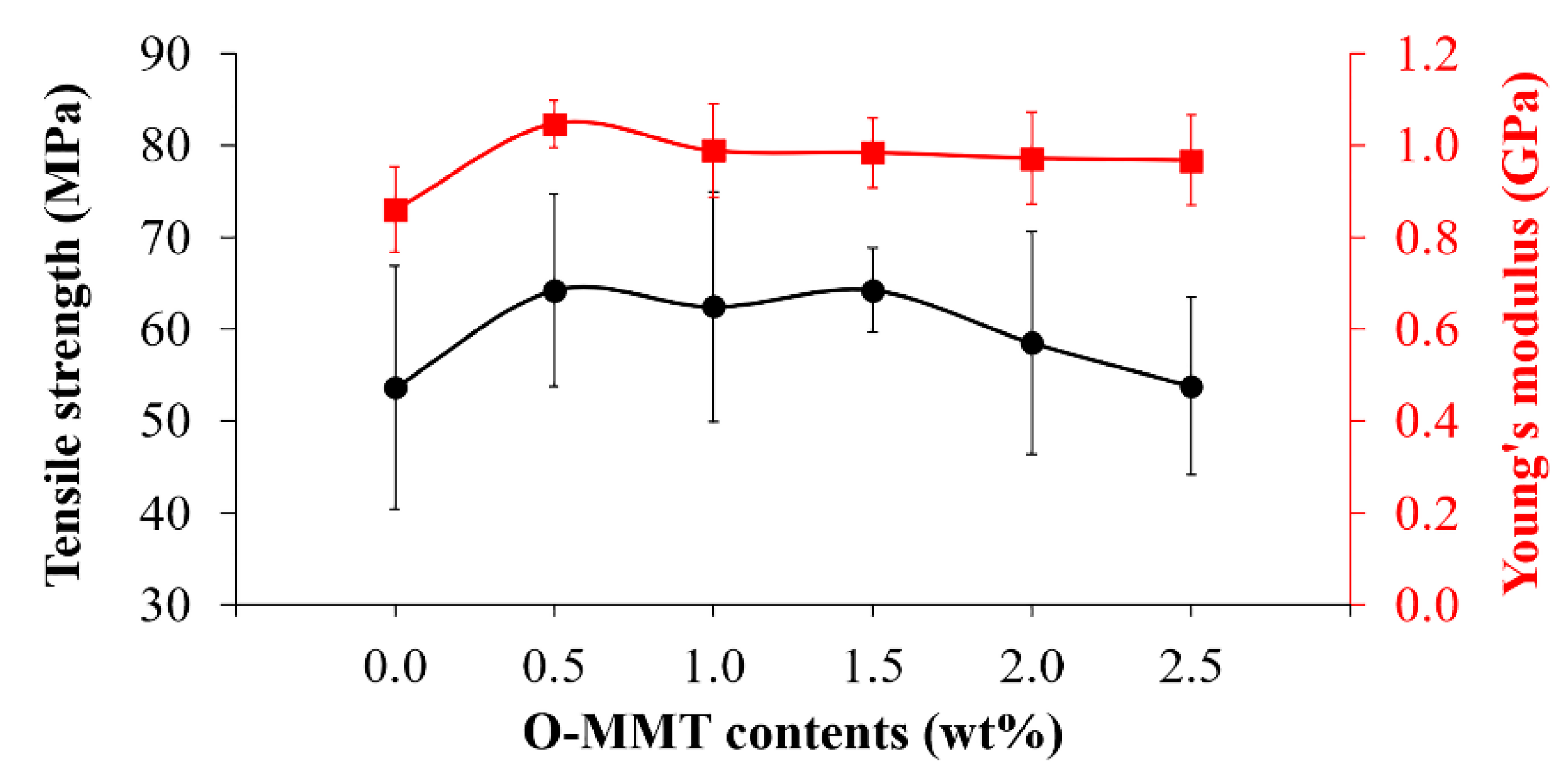


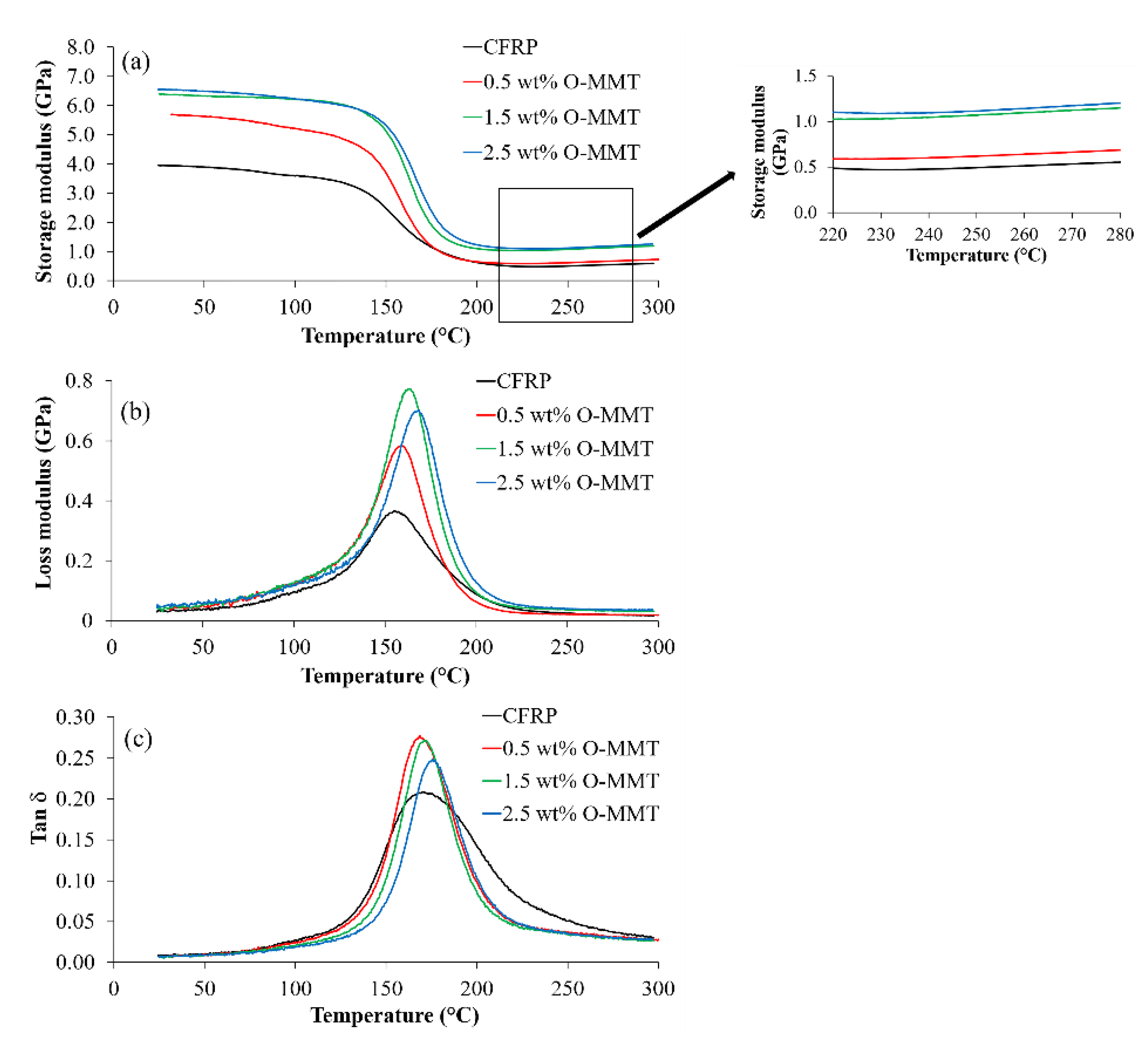
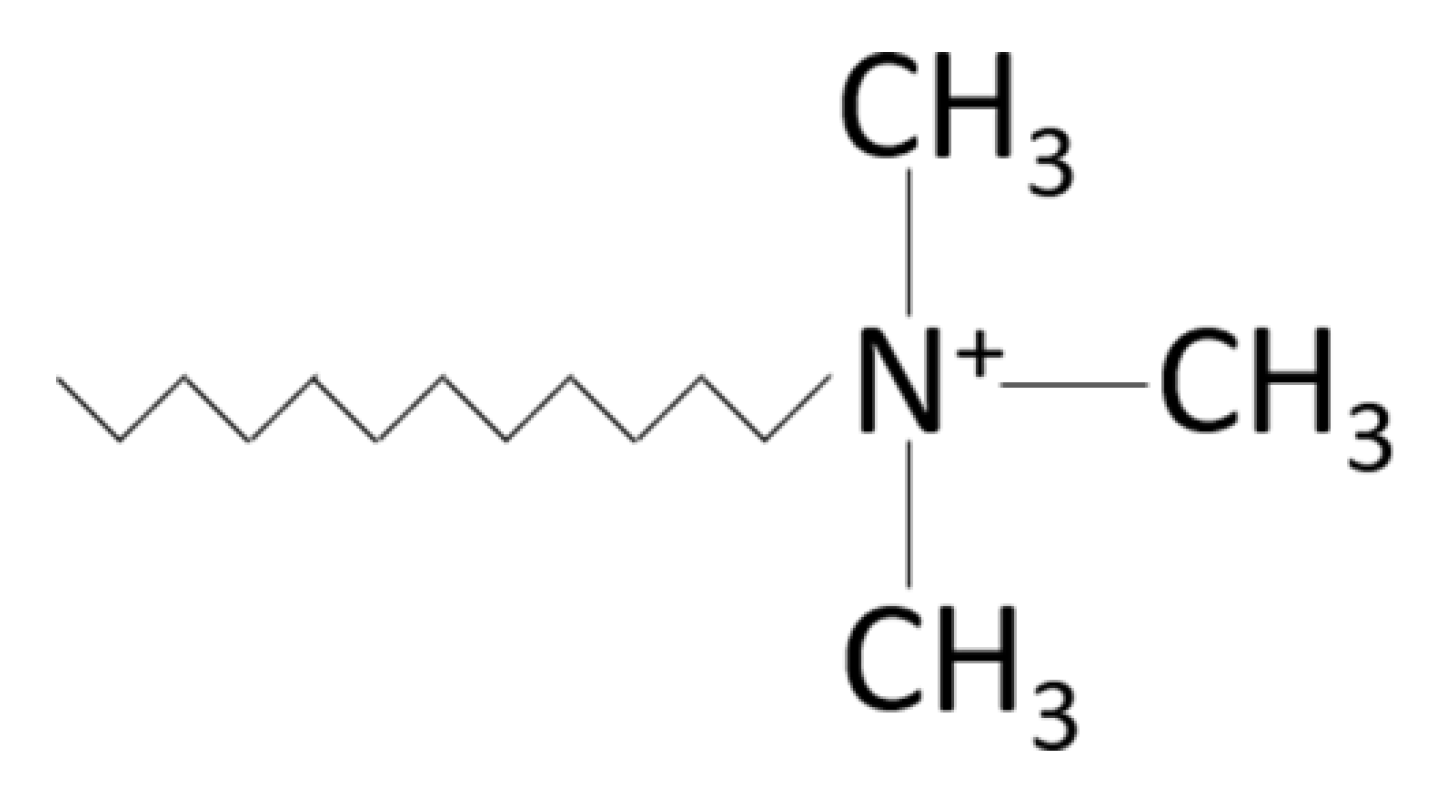

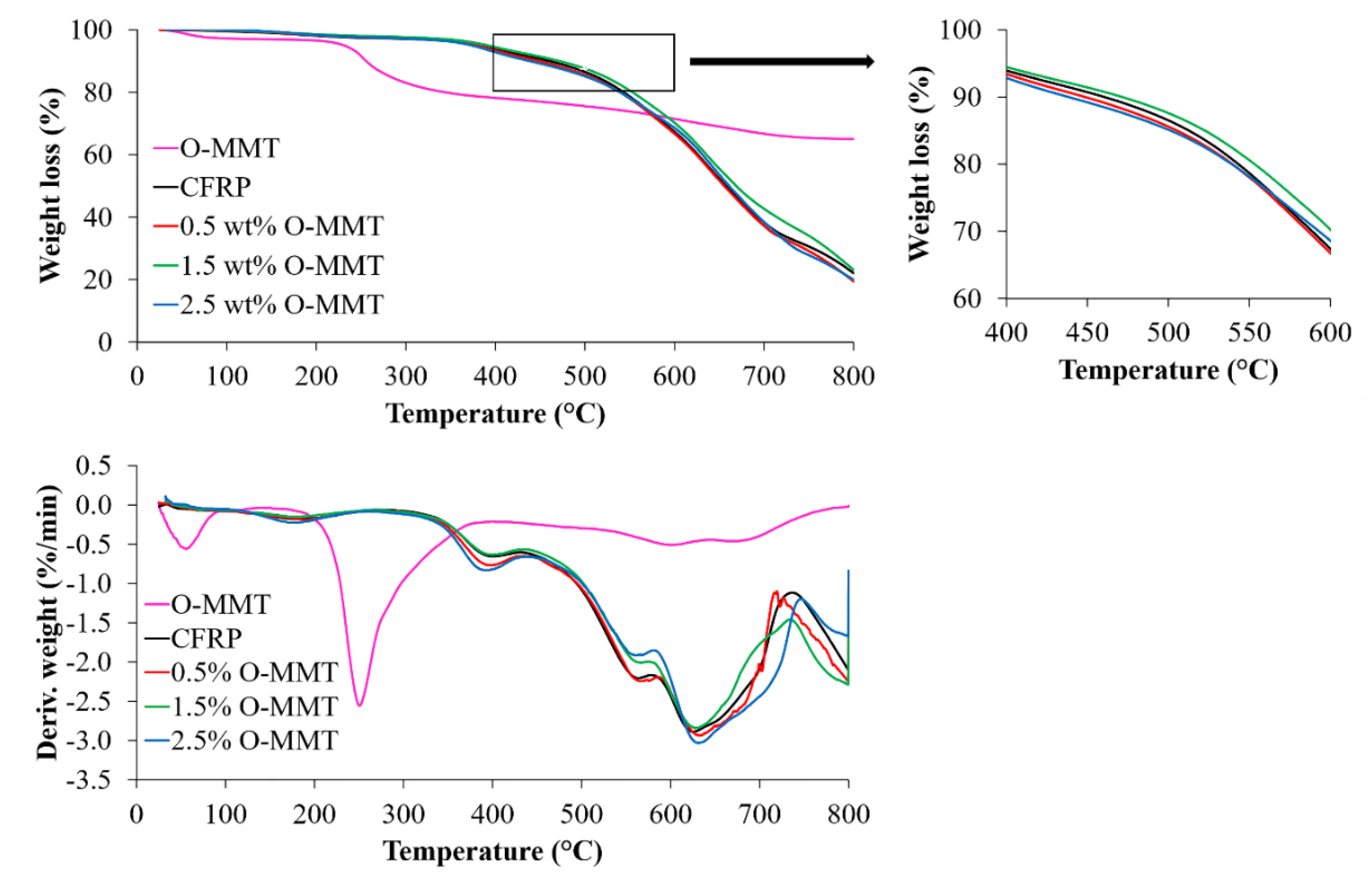
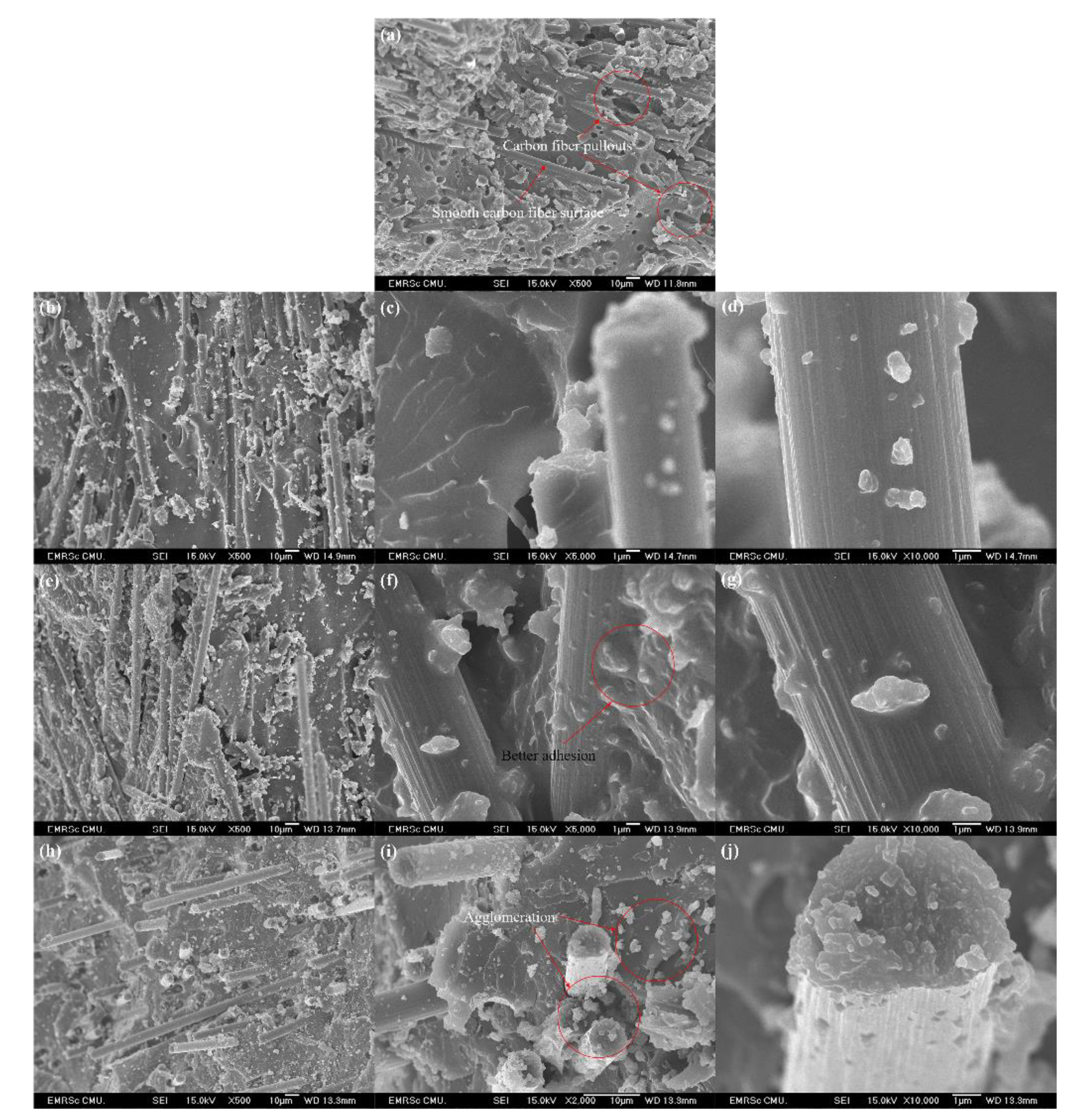
| Composites | Experimental Density (g/cm3) | Theoretical Density (g/cm3) | Void Content (%) |
|---|---|---|---|
| CFRP | 1.34 ± 0.02 | 1.42 | 5.6 |
| 0.5 wt% O-MMT | 1.30 ± 0.03 | 1.40 | 7.1 |
| 1.0 wt% O-MMT | 1.36 ± 0.03 | 1.38 | 1.4 |
| 1.5 wt% O-MMT | 1.37 ± 0.02 | 1.36 | -0.7 |
| 2.0 wt% O-MMT | 1.36 ± 0.01 | 1.34 | -1.5 |
| 2.5 wt% O-MMT | 1.35 ± 0.01 | 1.32 | -2.3 |
| Composites | E‘ at 30 °C (GPa) | % Change | E“at Peak (GPa) | % Change | Tg (°C) | % Change | |
|---|---|---|---|---|---|---|---|
| CFRP | 3.9 | - | 0.4 | - | 170.6 | - | 0.04 |
| 0.5 wt% O-MMT | 5.7 | 46.1 | 0.6 | 50.0 | 168.4 | −1.3 | 0.05 |
| 1.5 wt% O-MMT | 6.4 | 64.1 | 0.8 | 100.0 | 170.9 | 0.2 | 0.08 |
| 2.5 wt% O-MMT | 6.5 | 66.7 | 0.7 | 75.0 | 175.5 | 2.9 | 0.09 |
| Composites | T5%1 (°C) | Tdmax2 (°C) | R8003 (wt%) |
|---|---|---|---|
| O-MMT | 231.6 | 251.0 | 65.1 |
| CFRP | 383.5 | 623.5 | 22.0 |
| 0.5 wt% O-MMT | 379.8 | 632.1 | 19.5 |
| 1.5 wt% O-MMT | 392.1 | 630.0 | 23.3 |
| 2.5 wt% O-MMT | 373.8 | 633.1 | 20.0 |
Publisher’s Note: MDPI stays neutral with regard to jurisdictional claims in published maps and institutional affiliations. |
© 2021 by the authors. Licensee MDPI, Basel, Switzerland. This article is an open access article distributed under the terms and conditions of the Creative Commons Attribution (CC BY) license (http://creativecommons.org/licenses/by/4.0/).
Share and Cite
Pumchusak, J.; Thajina, N.; Keawsujai, W.; Chaiwan, P. Effect of Organo-Modified Montmorillonite Nanoclay on Mechanical, Thermo-Mechanical, and Thermal Properties of Carbon Fiber-Reinforced Phenolic Composites. Polymers 2021, 13, 754. https://doi.org/10.3390/polym13050754
Pumchusak J, Thajina N, Keawsujai W, Chaiwan P. Effect of Organo-Modified Montmorillonite Nanoclay on Mechanical, Thermo-Mechanical, and Thermal Properties of Carbon Fiber-Reinforced Phenolic Composites. Polymers. 2021; 13(5):754. https://doi.org/10.3390/polym13050754
Chicago/Turabian StylePumchusak, Jantrawan, Nonthawat Thajina, Watcharakorn Keawsujai, and Pattarakamon Chaiwan. 2021. "Effect of Organo-Modified Montmorillonite Nanoclay on Mechanical, Thermo-Mechanical, and Thermal Properties of Carbon Fiber-Reinforced Phenolic Composites" Polymers 13, no. 5: 754. https://doi.org/10.3390/polym13050754





